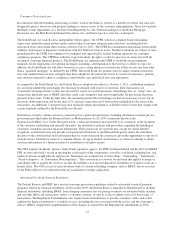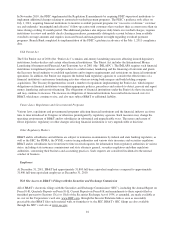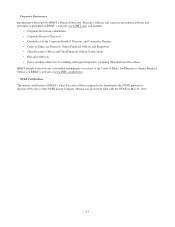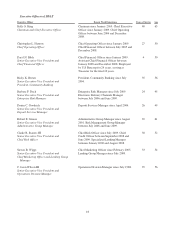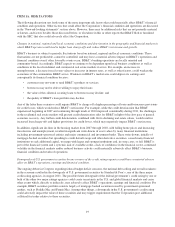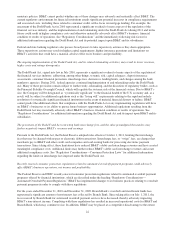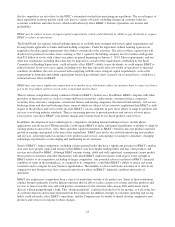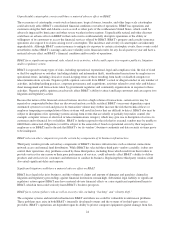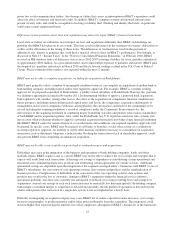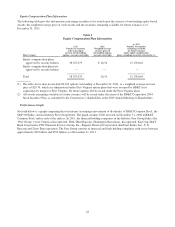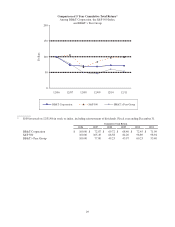BB&T 2011 Annual Report Download - page 21
Download and view the complete annual report
Please find page 21 of the 2011 BB&T annual report below. You can navigate through the pages in the report by either clicking on the pages listed below, or by using the keyword search tool below to find specific information within the annual report.in the real estate market and the general economy. These types of loans are generally less predictable, more difficult to
evaluate and monitor, and collateral may be more difficult to dispose of in a soft market. However, with respect to the
loans acquired in the Colonial transaction, the negative economic aspects of these risks are mitigated as a result of the
FDIC loss sharing agreements.
BB&T’s liquidity could be impaired by an inability to access the capital markets, an unforeseen outflow of cash or a
reduction in the credit ratings for BB&T or its subsidiaries.
Liquidity is essential to BB&T’s businesses. The capital and credit markets continue to demonstrate volatility and
disruption, despite modest improvements in the general economy during 2011, producing, in some cases downward
pressure on stock prices and credit capacity for certain issuers without regard to those issuers’ underlying financial
strength. If these levels of market disruption and volatility continue, worsen or abate and then arise at a later date,
BB&T’s ability to access capital could be materially impaired. Additionally, other factors outside of BB&T’s control,
such as a general market disruption or an operational problem that affects third parties or BB&T could impair BB&T’s
ability to access the capital markets or create an unforeseen outflow of cash or deposits. BB&T’s inability to access the
capital markets could constrain its ability to make new loans, to meet its existing lending commitments and, ultimately
jeopardize its overall liquidity and capitalization.
BB&T’s credit ratings are also important to its liquidity. These rating agencies regularly evaluate BB&T and its
subsidiaries, and their ratings are based on a number of factors, including the financial strength of BB&T and its
subsidiaries, as well as factors not entirely within BB&T’s control, including conditions affecting the financial services
industry generally. In light of the ongoing difficulties in the financial services industry and the housing and financial
markets, as well as the soft economic recovery in general, there can be no assurance that BB&T will maintain its current
ratings. A reduction in BB&T’s credit ratings could adversely affect BB&T’s liquidity and competitive position, increase
its borrowing costs, limit its access to the capital markets or trigger unfavorable contractual obligations.
The soundness of other financial institutions could adversely affect BB&T.
Financial services institutions are interrelated as a result of trading, clearing, counterparty, or other relationships. BB&T
has exposure to many different industries and counterparties, and BB&T and certain of its subsidiaries routinely execute
transactions with counterparties in the financial services industry, including brokers and dealers, commercial banks,
investment banks, mutual and hedge funds, and other institutional clients. Many of these transactions expose BB&T to
credit risk in the event of default of its counterparty or client. In addition, BB&T’s credit risk may be exacerbated when
collateral is liquidated at prices not sufficient to recover the full amount of the loan or derivative exposure due BB&T.
These types of losses could materially and adversely affect BB&T’s results of operations or financial condition.
Changes in interest rates may have an adverse effect on BB&T’s profitability.
BB&T’s earnings and financial condition are largely dependent on net interest income, which is the difference between
interest earned from loans and investments and interest paid on deposits and borrowings. The narrowing of interest rate
spreads, meaning the difference between interest rates earned on loans and investments and the interest rates paid on
deposits and borrowings, could adversely affect BB&T’s earnings and financial condition. BB&T cannot control or
predict with certainty changes in interest rates. Regional and local economic conditions, competitive pressures and the
policies of regulatory authorities, including monetary policies of the Federal Reserve Board, affect interest income and
interest expense. As discussed in “Market Risk Management – Interest Rate Market Risk (Other than Trading),” BB&T
has ongoing policies and procedures designed to manage the risks associated with changes in market interest rates.
However, changes in interest rates still may have an adverse effect on BB&T’s profitability. For example, high interest
rates could adversely affect BB&T’s mortgage banking business because higher interest rates could cause customers to
apply for fewer mortgage refinancings or purchase mortgages. While BB&T actively manages against these risks, if
BB&T’s assumptions regarding borrower behavior are wrong or overall economic conditions are significantly worse than
planned for, then the Corporation’s risk mitigation techniques may be insufficient to protect against the risk.
Changes in banking laws could have a material adverse effect on BB&T.
BB&T is extensively regulated under federal and state banking laws and regulations that are intended primarily for the
protection of depositors, federal deposit insurance funds and the banking system as a whole. In addition, BB&T is subject
to changes in federal and state laws as well as changes in banking and credit regulations, and governmental economic and
21






